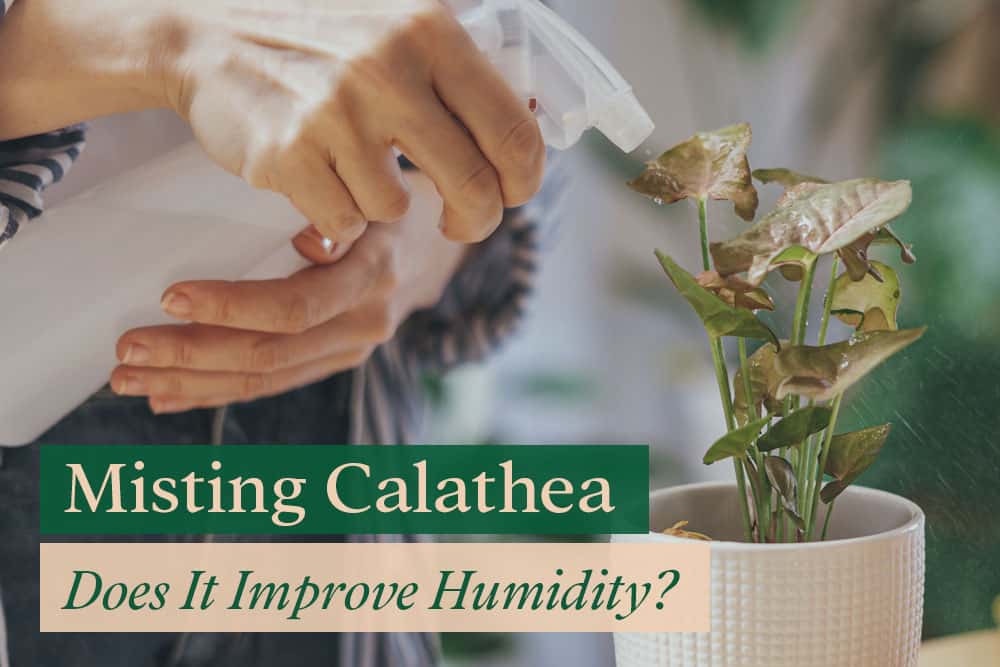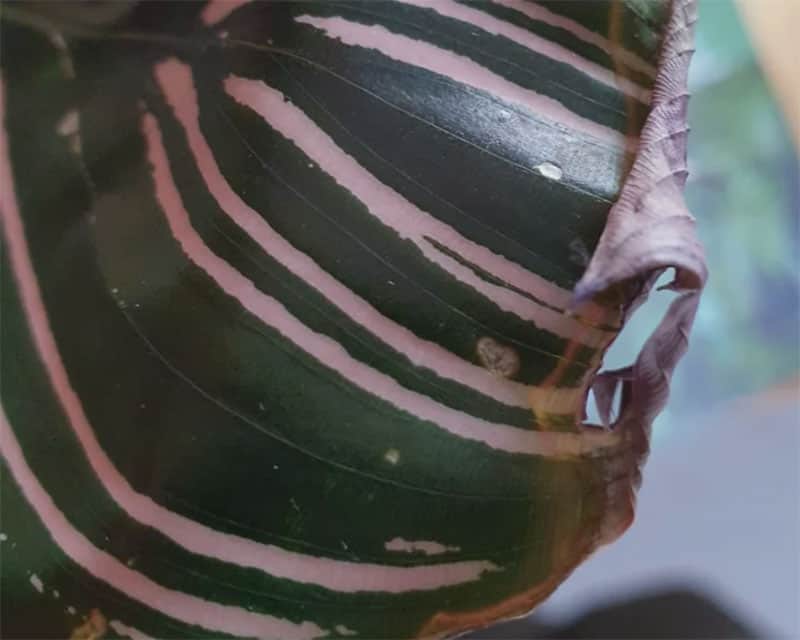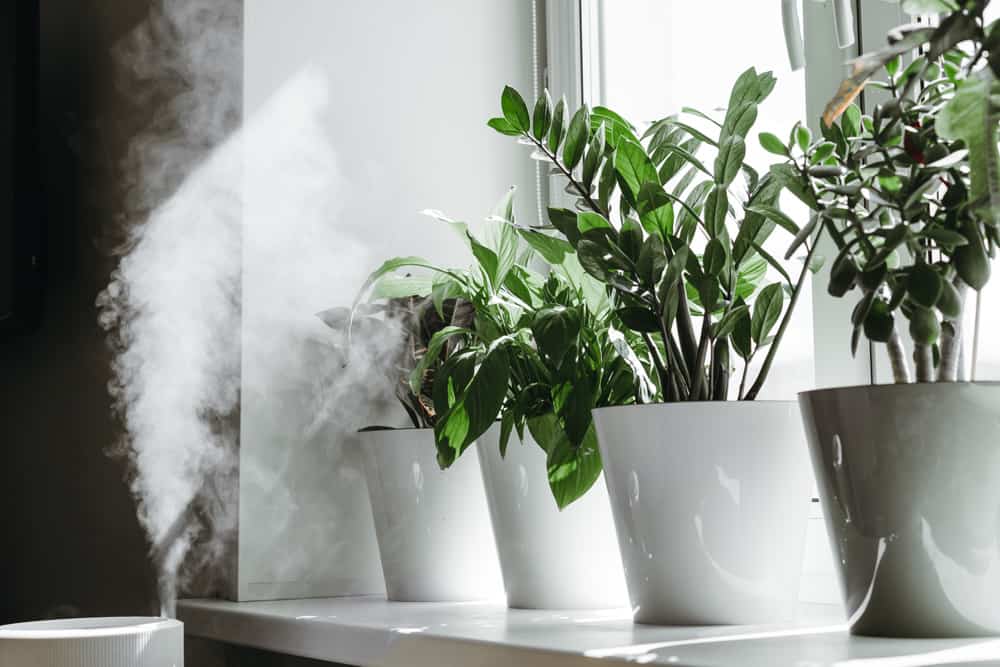
Even among my fellow houseplant parents, there is always a debate about misting your plants to increase humidity. So let’s settle this debate once and for all! Should you mist your Calathea?
Misting your Calathea is not the most effective method to raise the humidity around your plant since the effect is temporary and dissipates in 10–15 minutes. Using a humidifier and pebble trays are better ways to increase humidity for your Calathea.
In this article, we’ll look at why misting may not be the best option for providing humidity for your Calathea and explore better ways to raise humidity.
Let’s get started!
Bloomsprouts may earn an affiliate commission if you purchase something through recommended links.
Does Calathea like Humidity?
As a tropical plant, Calathea can be very sensitive to low humidity conditions.
Ideally, Calathea plants require a humidity level of at least 50%. More delicate varieties such as Calathea Orbifolia, Zebrina, and Medallion will need higher humidity levels at 60%.
Effect of low humidity for Calathea
The relative humidity level will affect how much moisture a Calathea loses through transpiration.
The rate of transpiration is accelerated as the humidity level drops. This can lead to dehydration if the plant does not have the means to replace the water lost.
Signs your Calathea needs more humidity.
The simplest method to determine if your Calathea is stressed due to humidity is to examine the plant itself. Some signs of low humidity include curling and dropping leaves, crispy browning leave edges, and overall poor plant condition.
Here are some signs of your Calathea needing extra humidity:

- The leaves and stems start to droop – This happens because there is not enough water supply for turgor pressure to push against the cell wall and keep the plant upright.
- The leaves start to curl – This is a common occurrence in dehydrated plants. They curl their leaves to lower the surface area of the leaves and slow down the transpiration rate.
- Leaves edge turning brown and crispy – After prolonged dehydration, the cells at the edges will die, turn brown and crispy.
While these signs can indicate low humidity, they are often mistaken for signs of underwatering or temperature stress.
So how do you know for sure if you have humidity issues?
Also read: Watering Calathea: How Often Should You Do it?
Determining the Humidity Levels in Your Home
The most accurate way of measuring your indoor humidity levels is by using a hygrometer. You may also use the device to monitor the indoor temperature.
If you don’t have a hygrometer, the ice cube technique is an easy method to estimate the humidity levels in your home.
Simply place ice cubes in a glass of water. If no condensation appears on the outside of the glass after more than 5 minutes, your room’s relative humidity is below 50%.
Should you mist your Calathea?

Misting is the act of gently spraying water onto the leaves of a plant with a spray bottle or garden sprayer.
But do you want to know if spraying your Calathea will help raise humidity?
Does misting raise the humidity in the room?
Misting does not raise the humidity level in the entire room; it only increases the humidity around the plant. The water mist evaporates rapidly; therefore, the effects are temporary and only last a few minutes.
Misting is more effective when plants are group together next to each other. The humidity can then build up in that area around the plants and last longer.
Best time to mist your Calathea
The best time to mist your Calathea is early morning as the sunlight has less impact on the evaporation rate of the water droplets.
Misting in the morning prepares them for the heat of the day, which may cause humidity to drop.
Can misting damage Calathea?
Misting can cause adverse effects on your Calathea plants if not done correctly and in moderation.
If your home has poor air circulation, over-misting can let the leaves get too wet and cause bacteria and fungus to germinate.
While over-misting in the winter might cause too much water in the soil, causing your dormant plants to become waterlogged and causing root rot.
Signs of over-misting
The most noticeable sign of over-misting is water droplets forming on the leaves and doesn’t dry up after a few hours.
A good indicator is to lift the leaves and look under the leaves for signs of condensation. An over-misted leaf will have droplets on its underside.
Other signs include yellowing leaves, dampness near the soil, and clumping together of the leaves.
If your Calathea has these symptoms, then stop misting immediately.
Better ways to raise humidity for Calathea
Instead of misting your Calathea plants, there are better ways you can improve the humidity levels in your home.
Using Plant Humidifier

The most significant advantage of using a plant humidifier is that it can effectively increase and maintain humidity at the desired level.
You can purchase a smart plant humidifier on the internet for a reasonable price.
A good humidifier will automatically adjust the output of the mist based on the desired humidity level you pick.
It will also let you operate non-stop for an extended period without needing to refill the water. This ensures that your Calathea are kept at the optimum level of humidity throughout the year.
Needless to say, you need to clean your humidifier regularly to avoid any issues with mold and bacterial growth.
Placing Plant on Pebble trays
If you’re looking for a more cost-effective method of raising humidity than using a humidifier, try placing your Calathea on top of a pebble tray filled with water.
Make sure the water level is just below the top of the pebbles. The pebbles will prevent the water from seeping through the drainage holes and making the plant’s roots too wet.
Then, as the water evaporates into the air, your plant will receive the humidity it needs. Simply refill the water once the pebble trays are dry.
Pebble trays are more effective if you place your Calathea indoor. The evaporated moisture will diffuse away quickly if it is placed outside.
Grouping plants together
As plants transpire, they add humidity to the air around them. This is why grouping your Calathea plants with your plant collections allows for optimum humidity.
The moisture that the plants release will create a humid microclimate within your space.
In addition, grouping plants together will make each plant look more beautiful and aesthetically pleasing.
Create a Terrarium for Your Plants
A trending and effective way to raise humidity for your plants is by creating a terrarium for your prized houseplants.
Place your plants in an aquarium with pebbles at the bottom. Fill it with water until it reaches just below the top of the pebble. Lastly, cover the aquarium to maximize the humidity level.
As the plant is placed in an enclosed environment, the moisture from evaporation and plants’ transpiration will not escape or dissolve away from the plants. As a result, the humidity level in the aquarium is maintained.
